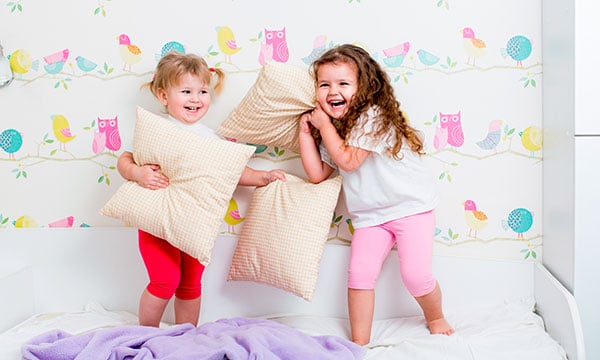There are no trifles in a healthy sleep – every accessory and every product plays an important role. After you have chosen a mattress and a protective cover, it’s time to buy a pillow for your child. A baby under 3 years old does not need a pillow if there is no doctor’s recommendation, and for older children, support of the cervical spine is already important.
Size
The size of the pillow can be any, as long as its parameters correspond to the size of the bed. The main thing is that it is not too small or large for the base of the bed and lies flat, without bends. For a child of 3-4 years old, a pillow with a length of 40-60 cm and a width of 30-40 cm is suitable, and from the age of 5 you can already choose a classic model – 50×70 cm. In order for the pillow to provide proper support for the head, its height should correspond to the length of the child’s shoulder from the protruding part of the humerus to the base of the neck. It is advisable for a 3-year-old child to buy a pillow at least 5 cm high, from 3 to 6 years old – 4-6 cm, at 5-7 years old, an anatomical pillow 6-10 cm high is already suitable.
Form
In shape: children’s pillows, like pillows for adults, can be square or rectangular. We advise you to choose a rectangular pillow so that the child does not lie on it with his shoulders. In the case of a spinal disease, you should seek advice from an orthopedic doctor so that he can advise the shape and height.
There is a huge assortment of various pillows on the market, but, despite this, we advise you to abandon products of unusual shapes, which often look like toys rather than an accessory for a comfortable and healthy sleep. The material of the cover should be breathable so that the child does not sweat. Give preference to cotton fabrics.
There should be no beaded decorations, large buttons, convex appliqués, etc. on the sleeping pillow.
Filler
In terms of composition: the choice of pillows is also wide: It is difficult to say unequivocally which filler is the best, and even a high price does not always mean similar quality, so a detailed study of the materials will help you make the right choice. If possible, choose materials of natural origin, such as bamboo or natural latex.
It is better to abandon feather and down pillows: as dust mites and various microorganisms that can harm the child are quickly introduced into them. If you still like down pillows, consider the option with artificial swan down. It feels almost indistinguishable from natural down, but insects will not get into it.
All-natural fillers have good transmittance: so the baby will sweat less. The downside of such fillers is difficult care and the likelihood of an allergic reaction. Fillers that are artificially made from natural or synthetic fibers are hypoallergenic and at the same time easy to care for, they can often be washed in a washing machine, but they are less breathable.
Popular Natural Fillers Are Wool And Buckwheat Husks
Pillows are usually made of sheep wool: less often of camel wool. Wool perfectly retains heat, quickly absorbs and removes moisture. The disadvantage of this filler is a short service life, as the wool cakes over time, and the pillow becomes uncomfortable.
In the past few years: buckwheat husks have become a popular material. Pillows with it are environmentally friendly, have an orthopedic effect and are affordable. In addition, such a filler is highly breathable and prevents the reproduction of harmful bacteria. Caring for them is quite simple: regular ventilation, drying, filler.
Of the disadvantages: only the rustle of such pillows can be distinguished, so buckwheat husks are unlikely to suit children who sleep lightly. Buckwheat is also a strong allergen. It is better to know in advance whether the child has a reaction to this material and take this into account when choosing a pillow.
The most affordable filler is holofiber: It is a lightweight synthetic material that is breathable, easy to wash, and dries quickly. However, a pillow with a synthetic filler will quickly begin to crumple and deform, so it must be replaced every 1-1.5 years.
Bamboo also quickly loses volume and elasticity: but unlike synthetic fibers, it just needs to be whipped more often. The pillow made of bamboo fibers can be changed every 2-3 years. The fiber that is used as a filler is made from young bamboo shoots. This is a lightweight, comfortable filler, it is hypoallergenic and has bactericidal properties. Such pillows are breathable, quickly evaporate moisture and do not accumulate unpleasant odors. They can be easily cleaned in the washing machine.
The best option for a child would be a latex pillow: Speaking of mattresses, we talked about what it is made of, talked about the characteristics. In pillows, latex also has an optimal degree of elasticity and rarely causes allergies. It is breathable and elastic, does not appear in dust mites and is easy to clean. And even despite the high cost, compared to other fillers, parents are more likely to opt for latex, as it supports the head and neck well, providing a pleasant sleep.
Care
After purchasing a suitable pillow: it is important to take care of it properly. Compared to pillows for adults, children’s pillows need to be washed more often or dry cleaned – once every 2-3 months. You need to ventilate the pillow on a flat surface every two weeks. To keep the pillow in shape longer, shake it every morning. It is better to use pillowcases made of natural fabrics, they should also fit the size of the pillow.
Choose a pillow for a child carefully. A well-chosen pillow will help to form posture and will contribute to a quick easy fall asleep.






